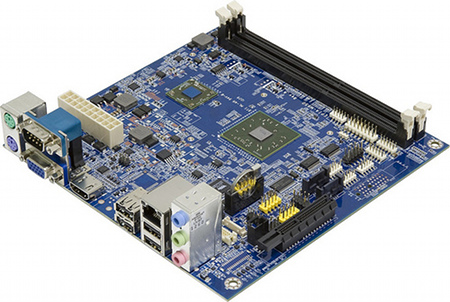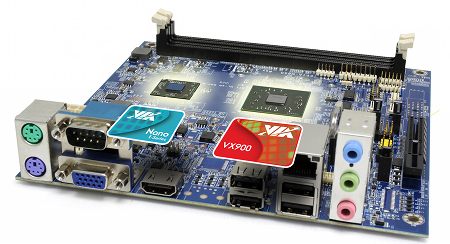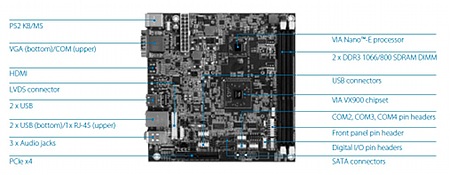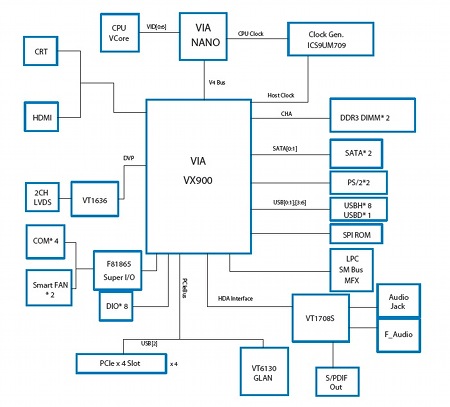Mini-ITX board targets embedded multimedia
Sep 8, 2010 — by LinuxDevices Staff — from the LinuxDevices Archive — 4 viewsVia announced a Mini-ITX board teaming 1.2GHz or 1.3+GHz versions of its embedded-oriented Nano E-Series 3000 processor with the HD video-ready VX900 core logic chip. The Via Epia-M850 offers support for HDMI, VGA, and LVDS displays, up to 8GB of DDR3 memory, and a PCI Express x4 expansion slot, the company says.
The Epia-M850 is aimed at OEM and ODM manufacturers of embedded multimedia devices, Via says. The board provides an HDMI output, HD video, and 5:1 surround sound without incurring heavy power usage or resorting to dedicated decoding hardware, the company adds.

Via Epia-M850
The E-Series is technically similar to the Nano 3000 series announced in November, which added support for Intel's SSE4 instruction set extensions, rather than the previous SSE3 set used with the standard Nano or Intel Atom. As a result of these enhancements, the Nano E-Series can deliver up to 20 percent greater performance than previous Nanos, while using up to 20 percent less power, claims Via.
The earlier Via Mini-ITX boards mentioned above employed the chipmaker's VX800 northbridge/southbridge, which was cited for its DirectX9 integrated graphics and HD audio. The Epia-M850, however, steps up to the newer VX900, first announced in March.
Touted for its ability to provide 1080p video playback "without incurring a heavy CPU load," the VX900 offers hardware acceleration for H.264 video. The 31 x 31mm device also accelerates MPEG-4/AVC, MPEG-2, VC-1, WMV-HD, AVS, Blu-ray, and "advanced browser streamed video technologies," all at "true HD" resolutions, the company adds.
According to Via, the VX900's ChromotionHD 2.0 video engine is also said to provide motion compensation, transform, de-blocking, and AVS support. Integrated display capabilities include a dedicated CRT interface, an LVVDS transmitter, a multiplexed display interface for DisplayPort and HDMI, and a 12-bit digital video output port (DVP) for an external HMDI/LVDS/DVI transmitter.

Epia-M850 ports
Via leverages these capabilities on the Epia-M850 by providing both VGA and HDMI ports on the board's coastline (above), plus an LVDS connector (with backlight control) on top of the device (below). Other I/O on the edge of the board includes two PS/2 ports, a serial port, four USB 2.0 ports, a gigabit Ethernet port, and three 3.5mm jacks that offer "smart 5:1 support," line output, line in, and mic in, according to the company.

Epia-M850 detail
(Click to enlarge)
According to Via, the Epia-M850 also provides a bevy of headers for additional I/O. These are said to serve up four additional USB 2.0 ports, a USB device port, "front-panel" audio, S/PDIF output, digital I/O (eight GPI and eight GPO), two SATA connectors, and three more serial ports, among other things.

Epia-M850 from the top
Compared to the company's previous Mini-ITX boards, the Epia-M850 accepts twice the memory, supporting up to 8GB of DDR3 RAM via its two DIMM slots. The device also includes a PCI Express x4 expansion slot, a watchdog timer, and wake-on-LAN functionality.

Epia-M850 block diagram
(Click to enlarge)
Features and specifications listed by Via for the Epia-M850 include:
- Processor — Via Nano E-Series clocked at 1.2GHz (fanless) or 1.3+GHz
- Chipset — Via VX900
- Memory — up to 8GB of DDR3 RAM
- Expansion — 1 x PCI Express x4
- Networking — 1 x gigabit Ethernet (rear panel)
- Other I/O:
- Rear panel:
- 2 x PS/2
- 1 x VGA
- 1 x HDMI
- 1 x RS232
- 4 x USB 2.0
- audio — mic in, line in, line out, "smart 5:1"
- Onboard headers:
- 4 x USB 2.0
- 1 x USB device port
- 1 x front-panel audio
- 1 x S/PDIF out
- 2 x DIO headers (8 x GPI and 8 x GPO)
- 1 x PS/2
- 1 x LVDS
- 3 x RS232
- 1 x LPC
- 1 x SMBus
- 1 x SPI
- 2 x SATA
- Rear panel:
- Operating temperature — 32 to 140 deg. F (0 to 60 deg. C)
- Dimensions — 6.7 x 6.7 inches (17 x 17cm); Mini-ITX
- Operating system - Linux, Windows 7, Windows CE, Windows XP/XPe
Stated Daniel Wu, vice president of Via's embedded platform division, ""The Via Epia M-850 will enable the creation of a wealth of next generation, HD-ready commercial devices."
A video of the Epia-M850
(click to play)
Further information
Via did not cite pricing or availability for the Epia-M850. More information may be found on the company's website, here.
This article was originally published on LinuxDevices.com and has been donated to the open source community by QuinStreet Inc. Please visit LinuxToday.com for up-to-date news and articles about Linux and open source.